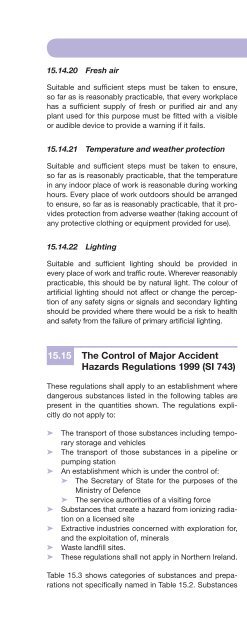Introduction to Fire Safety Management
Introduction to Fire Safety Management
Introduction to Fire Safety Management
Create successful ePaper yourself
Turn your PDF publications into a flip-book with our unique Google optimized e-Paper software.
15.14.20 Fresh air<br />
Suitable and suffi cient steps must be taken <strong>to</strong> ensure,<br />
so far as is reasonably practicable, that every workplace<br />
has a suffi cient supply of fresh or purifi ed air and any<br />
plant used for this purpose must be fi tted with a visible<br />
or audible device <strong>to</strong> provide a warning if it fails.<br />
15.14.21 Temperature and weather protection<br />
Suitable and suffi cient steps must be taken <strong>to</strong> ensure,<br />
so far as is reasonably practicable, that the temperature<br />
in any indoor place of work is reasonable during working<br />
hours. Every place of work outdoors should be arranged<br />
<strong>to</strong> ensure, so far as is reasonably practicable, that it provides<br />
protection from adverse weather (taking account of<br />
any protective clothing or equipment provided for use).<br />
15.14.22 Lighting<br />
Suitable and suffi cient lighting should be provided in<br />
every place of work and traffi c route. Wherever reasonably<br />
practicable, this should be by natural light. The colour of<br />
artifi cial lighting should not affect or change the perception<br />
of any safety signs or signals and secondary lighting<br />
should be provided where there would be a risk <strong>to</strong> health<br />
and safety from the failure of primary artifi cial lighting.<br />
15.15 The Control of Major Accident<br />
Hazards Regulations 1999 (SI 743)<br />
These regulations shall apply <strong>to</strong> an establishment where<br />
dangerous substances listed in the following tables are<br />
present in the quantities shown. The regulations explicitly<br />
do not apply <strong>to</strong>:<br />
➤ The transport of those substances including temporary<br />
s<strong>to</strong>rage and vehicles<br />
➤ The transport of those substances in a pipeline or<br />
pumping station<br />
➤ An establishment which is under the control of:<br />
➤ The Secretary of State for the purposes of the<br />
Ministry of Defence<br />
➤ The service authorities of a visiting force<br />
➤ Substances that create a hazard from ionizing radiation<br />
on a licensed site<br />
➤ Extractive industries concerned with exploration for,<br />
and the exploitation of, minerals<br />
➤ Waste landfi ll sites.<br />
➤ These regulations shall not apply in Northern Ireland.<br />
Table 15.3 shows categories of substances and preparations<br />
not specifi cally named in Table 15.2. Substances<br />
Summary of key legal requirements<br />
and preparations shall be classifi ed for the purposes of<br />
this Schedule according <strong>to</strong> regulation 5 of the Chemicals<br />
(Hazard Information and Packaging for Supply)<br />
Regulations 2002.<br />
In the case of substances and preparations with<br />
properties giving rise <strong>to</strong> more than one classifi cation, for<br />
the purposes of these regulations the lowest thresholds<br />
shall apply.<br />
15.15.1 Regulation 4 – General duty<br />
Every opera<strong>to</strong>r of a site that comes within the scope of<br />
the COMAH must take all measures necessary <strong>to</strong> prevent<br />
major accidents and limit their consequences <strong>to</strong><br />
persons and the environment.<br />
15.15.2 Regulation 5 – Major accident prevention<br />
policy<br />
Opera<strong>to</strong>rs must prepare a document setting the policy<br />
relating <strong>to</strong> the prevention of major accidents. The policy<br />
must:<br />
➤ Guarantee a high level of protection for persons and<br />
the environment by appropriate means, structures<br />
and management systems<br />
➤ Include suffi cient particulars <strong>to</strong> demonstrate that<br />
the opera<strong>to</strong>r has established a safety management<br />
system<br />
➤ Be kept up <strong>to</strong> date and revised when establishment<br />
or installation is changed<br />
➤ Implemented by the opera<strong>to</strong>r.<br />
15.15.3 Regulations 7–8 – <strong>Safety</strong> report<br />
Prior <strong>to</strong> the start of construction of an establishment<br />
which will come within the scope of COMAH, the opera<strong>to</strong>r<br />
must produce a report containing information relating<br />
<strong>to</strong> the prevention of major accident hazards and the limitation<br />
of their consequences from the site <strong>to</strong> the competent<br />
authority (normally the health and safety executive).<br />
The opera<strong>to</strong>r must also provide any further information<br />
that the competent authority may request.<br />
Where a safety report has been sent <strong>to</strong> the<br />
competent authority the opera<strong>to</strong>r must review it:<br />
➤ At least every 5 years<br />
➤ When there is a change of circumstances or information<br />
affecting the plan<br />
➤ Whenever the opera<strong>to</strong>r makes a change <strong>to</strong> the<br />
safety management system.<br />
When an opera<strong>to</strong>r proposes <strong>to</strong> modify his site or installation<br />
he must, before making any changes, review, and<br />
where necessary revise, the safety report prepared in<br />
367

















